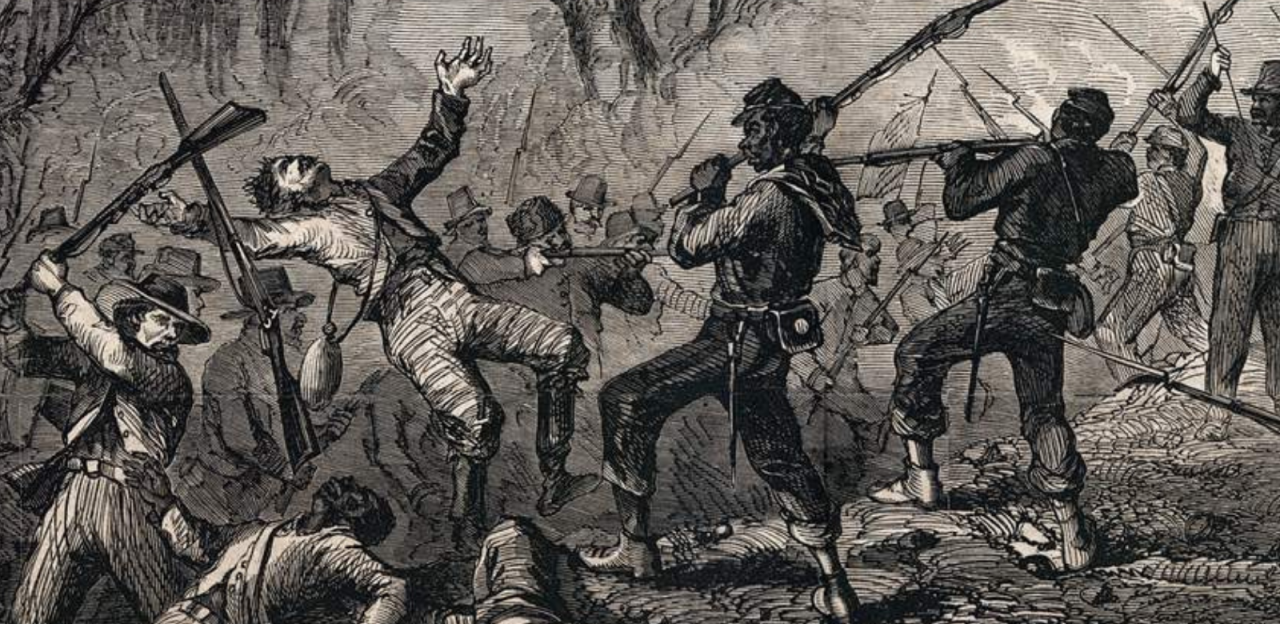Milliken's Bend

The Battle of Milliken's Bend
In January, 1863, as Maj. Gen. Ulysses S. Grant’s Army of the Tennessee advanced on the strategic Mississippi River town of Vicksburg, he established supply depots and training camps for black soldiers in northeastern Louisiana at Young’s Point, Milliken’s Bend, and Lake Providence. As Grant encircled Vicksburg in late May, these depots and training camps were the targets of desperate Confederate efforts to aid the besieged garrison. It was hoped the capture or destruction of these posts would compel Grant to loosen his grip on Vicksburg and enable the Confederate troops under Lt. Gen. John C. Pemberton to cut their way out. The largest and most significant of these actions occurred at Milliken’s Bend on June 7, 1863.
Confederate Maj. Gen. Richard Taylor, who commanded the District of Western Louisiana, ordered the Texas Division of Maj. Gen. John G. Walker into Madison Parish. Taylor’s plan called for Walker’s mixed infantry and cavalry division to launch simultaneous assaults at Milliken’s Bend and Young’s Point, while the 13th Louisiana Cavalry Battalion attacked the Federal enclave at Lake Providence.
The Texans left their encampment at Richmond at 7:00 p.m. on June 6 in hope of arriving at the enemy camps by sunrise. Here at Oak Grove plantation the road forked. Walker sent Brig. Gen. Henry McCulloch’s brigade north to strike Milliken’s Bend and directed Brig. Gen. James M. Hawes’ brigade east toward Young’s Point. Walker himself remained at Oak Grove with a third brigade under Col. Horace Randall as a ready reserve. McCulloch’s Brigade, 1,500 strong, arrived within a mile and a half of Milliken’s Bend at 2:30 a.m. June 7 when it was fired upon by Federal pickets.
Increased Confederate activity in the area convinced Col. Hermann Lieb, who commanded five regiments of former Mississippi and Louisiana slaves at Milliken’s Bend, that his post was in danger. Lieb requested reinforcements, in response to which the white 23d Iowa Infantry was sent from Young’s Point. Flag Officer David D. Porter also sent the ironclad USS Choctaw. As Federal pickets began falling back, Lieb placed his men on the levee behind cotton bales. His black troops were recently recruited, poorly trained, and poorly armed. In many cases the regiments were also poorly led. But they had the advantage of position and were supported by the powerful guns of Choctaw.
McCulloch placed his Texans in line of battle astride the Richmond road and drove the Federals from hedgerow to hedgerow. Once past the hedgerows McCulloch reformed his brigade and sent his men forward crying “No quarter for the officers, kill the damned abolitionists, spare the niggers.” The Texans scaled the levee and closed on the enemy. A withering volley stunned the Confederates, but the blacks were unable to reload their cumbersome weapons before the Texans were upon them. Clubbed muskets and bayonets were freely used as the Texans surged over the cotton bales and drove the blacks through their camps to a second levee fronting the river. The timely arrival of a second gunboat, USS Lexington, forced McCulloch to retreat.
The attacks at Young’s Point and Lake Providence came to nothing. In the engagement sat Milliken’s Bend, McCulloch suffered 185 casualties, while Lieb lost over three times that many. The action at Milliken’s Bend showed that former slaves would fight hard, and helped lead to the acceptance of black troops wearing Union blue.


